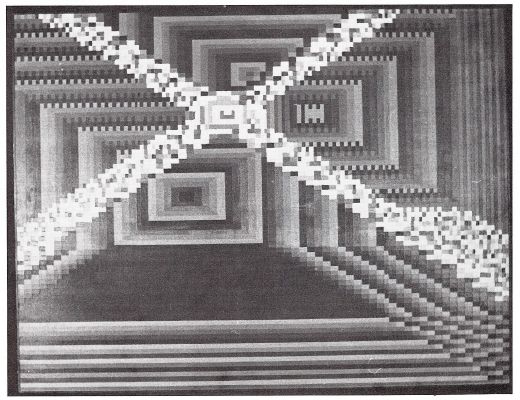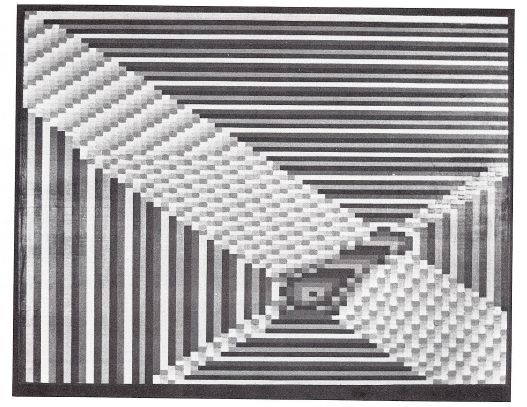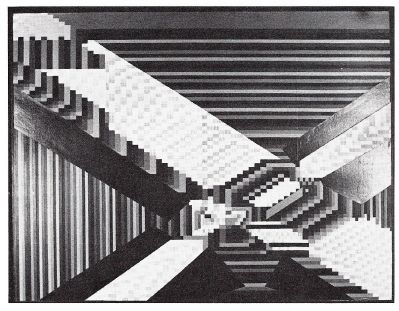JOSEPH SCALA
As early in my life as I can remember I wanted to create art and be an artist. Most of my pre-school time was spent drawing and making things, collecting junk for no other reason than I liked the color or the shape. Elementary school was standard city public education with its multi-diversions and cueing regimentation. But the desire and the artistic production did not wane. City high school was a mixture of excitement, encouragement and fear. Gang fights were the order of the day and walking into the gym locker room to find someone sprawled out on the floor with a bloody broken nose was not very unusual; it didn't even make the school paper. Then we moved to the suburbs with the 'good' school. In the 'good' school there weren't any gang fights—just mischievous teenagers who if they happened to be on a school team had their egos blown by the coaches to the point where they thought they could do anything and get away with it and they usually did. This was the 'good' school. Reading, writing, arithmetic and football, not necessarily in that order, is what makes boys into men and the girls—well, the girls were supposed to get the right man and not worry about anything else. So in the 'good' school one took math, physics, chemistry, football and if you couldn't make it, they put you in art. Naturally, I took the important courses because I knew what was necessary to be a man.
Art school? Do you want to be a bum? Are you prepared for art school? —you don't have a portfolio! Study chemistry—chemists make big money. One year of chemistry from 8 a.m. to 6 p.m. in a technical trade college and then a transfer to a liberal arts college. My first art course in college was an art history course taught by Jules Olitsky. His opening remark was "Does anyone want to buy a painting for a few hundred dollars?" The class laughed! "Professor Olitsky, I'd like to show you my work." "I believe you've got something, Scala. Keep working." God damn! Somebody wants me to make art! Tuition has to be paid—nobody is going to support three years of art—major, study mathematics, take art on the side. Graduated with a B.S. in math—now what? Get a job, get married, have a child and make art.

The job: first engineering aide in a large defense plant, thought about using the defense plant facilities to make art. Nine months employment, promise of promotion to assistant engineer within several additional months, I resigned! — couldn't stand it. Three months of travel in Europe returning home penniless, carless and jobless. Now mathematics teacher in secondary school.

The art: where is my head? I'm thinking equations and technology all day...why not combine those ideas in the art? This is where I left traditional art and started making kinetic art. Moving sculpture that generated virtual volumes and incorporated time as a fourth dimension. This brought some success, a few sales and some important exhibitions. Decision time—to continue teaching full time in secondary school and making art nights, weekends and during vacations; go to graduate school for an MFA and try to get a college teaching job; or just stop gainful employment and make art. I chose to go to graduate school and there is where I was first introduced to the computer. I took a course in computer graphics for architects and made my first cal-comp drawing. The second drawing I tried on my own was a little disappointing. I got the x and y coordinates mixed up and my output was a large black mess centered in the middle of the page. At that point I decided that the computer was not ready for the artist and I went back to making interactive sculpture. After graduating from Cornell I got a teaching position in the Department of Experimental Studios at Syracuse University. In collaboration with an engineering colleague I designed and implemented a new course in art-engineering which included topics such as mechanics, light, electronics, and their aesthetic applications. Searching for contemporary technology to apply to art I took a workshop in computer-graphics from Dr. Ken Knowlton and using his EXPLOR software system, which he designed for artists, a new world opened up to me. EXPLOR offered me a system that could be understood visually and enabled me to learn Fortran by applying the Fortran language to the solution of graphic problems as opposed to the traditional mathematical approach. This I believed would be the best way to teach art students and artists how to program in Fortran and make graphic art at the same time. I immediately acquired the EXPLOR system and brought it back to Syracuse University and proceeded to set up and offer a course in computer-graphics especially for art students. It worked! Within a few weeks art students who had never seen a computer and who had little or no mathematical training were writing programs in Fortran and producing graphic images.
The EXPLOR images are painted on a high speed line printer making the time between execution and finished print extremely fast. In fact, with our DEC-writer terminals the image is typed back almost immediately. This is a tremendous advantage for the artist because he/she can see the results and make changes in a more or less interactive continuous way. My students came from a number of different disciplines which made the total class output tremendously varied. Printmakers photographed their computer output, made kodaliths and used the kodaliths to produce photo-silkscreens, photo-lithos, photo-etchings and embossings. Weavers used their designs to produce needle points, tapestries and rugs. Others painted on the computer prints, drew on them, colored them with various mediums and made collages. Still others made animated films and video tapes. With the assistance of the Syracuse University computing center and a talented computer specialist named David Carr, we were able to get the EXPLOR system outputted on our VB10-C display. The display is a cathode ray tube which looks like a T.V. and can produce the programmed images as points of light on the screen. The images can then be sequenced so that they can be filmed a single frame at a time to make an animated movie. This capability led to an interdisciplinary course which was put together between my wife, Patsy Scala, who is an expert in video art and television, a colleague from the film department and myself. We were able to successfully integrate all three art forms and produce color films and color video tapes of unusual design and effect. We offer this course at Syracuse University during the summer. The computer-art program in the Department of Experimental Studios now includes a number of different software systems which can be out-putted on the line-printer, the DECwriter terminals, the VB 10-C display and the cal-comp plotter. One system presently being implemented can be used to design 3-d sculpture, another can write poetry and yet another created by Ruth and Jay Leavitt can stretch patterns into different shapes.

In my own work I have used the computer to generate animated sequences which have been transferred from film to video and back to film in collaboration with my wife. At the present time my greatest interest has been in generating two-dimensional graphic images and allowing random elements to integrate my basic pattern with preset limits of minimum and maximum dimensions. The random factor is of interest to me because it gives the computer a limited decision-making capability in my design which is similar to the controlled randomness that Pollock achieved in dripping paint on to a canvas. My problem has been that where computer images seem to integrate naturally into film and video the hardcopy output often has an artificial machine look. For this reason I have found it necessary to bring my hand onto the final result through painting and drawing. I have generated line-printer designs using the EXPLOR software system with multi-colored ribbons. As far as I know I was the first artist to use different colored line printer ribbons to make original works of computer art. The results of this technique are interesting but I still feel the need to work in black and white and combine that with other techniques and mediums to bring my final work into a more traditional aesthetic plane.
The artist has moved in on a system which was originally designed for the military, scientific and business communities. The available hardware was designed for efficiency and speed of output and did not take into account becoming the standard device for special effects, as well as in abstract video art and animation. Environmental artists will design around and with the computer. In addition I believe the use of the computer to make art has had a startling effect on the computer technologist. Aesthetics has become a major parameter in the technical decision-making process and as more artists become technologically oriented and more scientists become aesthetically aware the future may bring us back to a true union of art and science and the genius of a Da Vinci.
The computer is definitely a tool for the production of art but it is more than just a tool. It is a new way of communicating between persons and the technological environment. The computer is the electronic interface between human thought and aesthetic expression which will allow human kind to tap and communicate those cords of humanity necessary for the continuation of human existence with and in our scientific-technological culture.
Syracuse, New York
October 1975
Return to Table of Contents | Previous Section | Next Section

